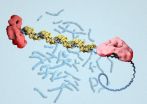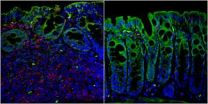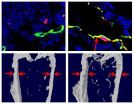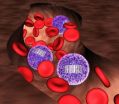Investigators from the University of Toronto Faculty of Medicine, the Institute for Clinical Evaluative Sciences (ICES) and the University Health Network looked at data from acute care facilities in Ontario over nine years. They examined stroke care delivery and outcomes for two groups: those who had a stroke in the community (about 32,000 people), and those who had a stroke while already hospitalized for another reason (just over 1,000 cases), such as, for example, a hip replacement. The results were surprising.
"Intuitively, you would imagine that having a stroke in the hospital is the best place possible, and that is just not the case," says Dr. Alexandra Saltman, a third year internal medicine resident at the University of Toronto, and one of the authors of the Code Stroke on the Ward study.
Compared to the patients brought into a hospital from the community, people with in-hospital strokes:
waited significantly longer from the time stroke symptoms were recognized to neuroimaging (i.e., a CT scan);
waited longer from the time a stroke was confirmed to getting clot-busting drugs; and
were less likely to receive clot-busting drugs than those who were admitted following strokes outside of hospitals, even when they were eligible.
The study's authors made the comparisons using the Heart and Stroke Foundation's Canadian Stroke Best Practice Recommendations and the American Heart Association best practice guidelines for stroke care. After adjusting for age and other factors, the in-hospital stroke patients also had longer hospital stays and were more likely to be disabled.
"There is evidence that people do worse when they have a stroke in the hospital, and not just because they are already sicker," says Dr. Saltman.
She suggests two possibilities for what seems to be a lag in response, despite the fact that the patient is surrounded by health-care professionals.
First, the signs of a stroke are too often overlooked. When patients are admitted for other medical reasons (for example, heart surgery or pneumonia), hospital staff on that ward are understandably focused on that ailment or condition, and are not specifically looking for stroke symptoms.
"We're all human, and things get missed," says Dr. Saltman. "In a medically or surgically complicated patient, it may be harder to detect the stroke symptoms than in someone with no other acute issues."
This is an important reminder for hospitals to promote awareness of stroke. "Awareness of stroke signs and how to react is important for all health care professionals, in any specialty," says Patrice Lindsay, director of stroke best practices and performance for the Heart and Stroke Foundation. "The reality is that people can have a stroke in hospital regardless of why they are hospitalized."
When an in-hospital stroke is identified, Dr. Saltman attributes a slower than expected response to a second factor: a lack of a standardized approach. When patients are taken to the hospital with a suspected stroke, "code stroke" protocols are in place. A team is ready to assess the patient, obtain and read images, and implement the appropriate treatment.
"When somebody has a stroke on a ward, no such standardized approach exists," says Dr. Saltman.
Lindsay says that it is mainly a systems and organizational issue, not the healthcare professionals who care for patients; it highlights an opportunity for increased awareness, standardized protocols and better coordination between internal departments throughout all acute care hospitals.
"Hospitals already have sound protocols on handling strokes coming in from the community," she says. "We need the same awareness and services within the hospital for patients who are already admitted, to ensure their rapid access to stroke care."
Hot topic in stroke: awareness of the signs Recognizing the symptoms of a stroke and acting quickly can prevent disability and save lives. A survey for the Heart and Stroke Foundation found that two-thirds of Canadians arrive at hospital too late to meet the treatment window for clot-busting drugs (or other interventions that can minimize the effects of a stroke). Whether people have a stroke in the community or in the hospital, the clock is ticking. To respond as fast as possible, it's vital for the public and health care professionals alike to know the stroke signs and to treat them as a medical emergency:
Weakness: Sudden weakness, numbness or tingling in the face, arm or leg. Trouble speaking: Sudden temporary loss of speech or trouble understanding speech. Vision problems: Sudden loss of vision, particularly in one eye, or double vision. Headache: Sudden severe and unusual headache. Dizziness: Sudden loss of balance, especially with any of the above signs.
Quick action in recognizing and responding to the signs of stroke is essential, as the clot busting drug tPA can reduce the severity of a stroke and reverse some of the effects, but only if it is administered within a few crucial hours after symptoms begin for someone who has a stroke caused by a clot. Research creates survivors
This research highlights the opportunity to create more survivors though increasing awareness and developing in-hospital protocols ─ and for more good news stories such as that of Chloé Rodier.
In 2011, the then 16-year-old, who was hospitalized for pneumothorax, woke up with a strong headache. "I asked my mom to check with the nurses if I could have some Aspirin. When I tried to try to take the pills with my left hand, I saw that it wasn't moving. I looked at my mom and told her that I couldn't feel my arm. The specialists got there quickly, and many tests had to be done to diagnose the stroke. The doctors told me that I was lucky, that things could have been worse: I could have lost my speech and memory."
INFORMATION:
The Canadian Stroke Congress is a joint initiative of the Heart and Stroke Foundation and the Canadian Stroke Consortium.
Statements and conclusions of study authors are solely those of the study authors and do not necessarily reflect HSF or CSC policy or position. The Heart and Stroke Foundation and the Canadian Stroke Consortium make no representation or warranty as to their accuracy or reliability.
About the Heart and Stroke Foundation
The Heart and Stroke Foundation's mission is to prevent disease, save lives and promote recovery. A volunteer-based health charity, we strive to tangibly improve the health of every Canadian family, every day. Healthy lives free of heart disease and stroke. Together we will make it happen. heartandstroke.ca
For more information and/or interviews, contact the
CSC 2014 MEDIA OFFICE AT 778-331-7623 (Oct 4-7)
OR
Amanda Bates
Curve Communications
amanda@curvecommunications.com
office: 604-684-3170
cell: 604-306-0027
Gina Vesnaver
Curve Communications
gina@curvecommunications.com
office: 604-684-3170
cell: 604-317-6129
Congress information and media registration is at http://www.strokecongress.ca
After October 7, 2014, contact:
Jane-Diane Fraser
Heart and Stroke Foundation of Canada
jfraser@hsf.ca, (613) 691-4020



